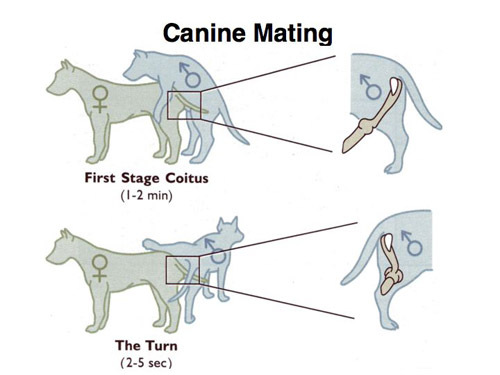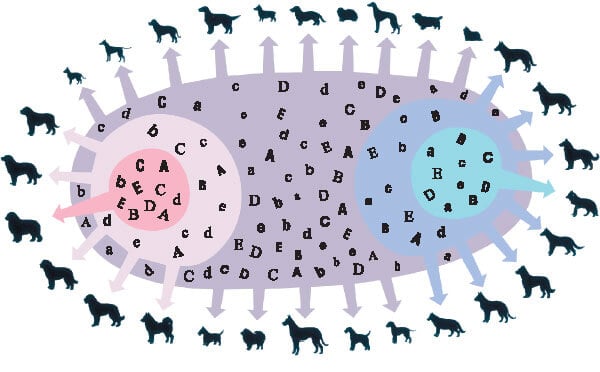Random dog breeding can create a surprising litter full of puppies with unpredictable physical and behavioral traits. This is a controversial topic in which some support breeding random dogs together, and others are firmly against it. If you are a breeder, it is a topic which you may be interested in understanding more.
In order to draw your own opinion, we have collected and explained the pros and cons of doing so. This includes the health aspect such as expanding the gene pool or difficulties with birth. It also considers business issues such as selling costs and consistent production of phenotypic characteristics.
Can I Breed Random Dogs Together?
As all dogs are the same species (Canis familiaris), you can breed any breed with one another. However, there are many potential health problems that you need to consider. Firstly, the potential risks when mating two different dog breeds. Secondly, which breed should be the dam and which should be the sire.
Firstly, how will the breeds copulate? You need to consider their differing height, weight, and general body proportions. Ideally, you will want to be breeding two breeds that are a similar height and weight, although this may not always be the case. When you have two breed types that are different in size you may want to consider artificial insemination. If this is not an option, you want to either cancel the mating or make it as painless as possible. When a tie is made, both individuals should be in as comfortable of a position as possible. This is done by deciding which breed will be the male and which is the female.

The dam should always be the larger breed for multiple reasons in mating. Firstly, the male needs to be an appropriate height to penetrate the female. Too tall and he will not be able to do so, too large and he can cause the female pain. If the male is smaller than the female, she can lie down while he mounts her and she will not be in any unusual discomfort. Furthermore, after a tie is made, the female and male can be joined together for up to half an hour. During the tie, you need to supervise both individuals, especially the female to keep them calm and still. The female can severely hurt the male if she stands, runs or becomes otherwise agitated.
A good way to facilitate the breeding of two unknown dogs is to introduce them to each other a few times prior to the breeding day.
Benefits of Breeding Random Dogs
Firstly, let’s examine the many benefits of randomly breeding dogs such as genetic diversity, creating designer breeds and improving offspring traits for jobs such as service dogs.
Creating designer breeds
A designer breed is defined as a puppy who has parents that are two purebred dogs from two different breeds. Another reason for their name is because these breeds are often highly desirable and more expensive. These designer breeds are currently very popular and more newly defined compared to most other pure breeds. Labradoodles and Yorkipoos are two of the most popular hybrid dog breeds today. Poodle mixes are very common amongst hybrid dogs due to the hypoallergenic properties found within the breed.
[adwithin]
Random breeding of different breeds can lead to new offspring with either desirable physical or behavioral traits. Breeders and buyers looking for dogs for specific roles may be interested in a dog with a certain trait, such as strength for carrying items. Or they may be interested in physical appearances such as long legs or a long coat for dog shows. New designer breeds have new traits that humans can give purpose to.
Increase genetic diversity for a canine study
Scientific and professional studies will often contact well-renowned breeders and ask for the data of all their breeding dogs and litters. This increases the studies’ sample size, increasing the validity of the results. It can also benefit breeders. Their details can be included at the end of a study for others to view, thereby reaching a big audience.
A high-quality study has results from many different individuals to minimize bias. By breeding random dogs together, their puppies’ physical and behavioral characteristics can potentially all be different in a litter. This will more accurately represent nearer all of the different dog types that exist. As opposed to one breed type being used which will induce bias through similar characteristics.
For example, in a study concerning dog temperaments towards vacuum cleaners, if you were only to use a breed such as the Labrador Retriever, the results may be more positive. Generally, this breed is more docile so it will not accurately represent the species.
Help improve traits in service dogs
Different service dog roles use different common breed types. This is because specific breeds have the most suitable traits for the task at hand. However, that is not to say some individuals cannot be better suited. When breeding random dogs together, the offspring may have increased beneficial traits such as obedience, agility, and patience.
Two of the most commonly used dog breeds for the blind are Labrador Retrievers and Golden Retrievers. Both of the breeds are known for being friendly. But they differ in their energy levels and training times. Although they are both above average in intelligence, many find training Golden Retrievers a quicker process as they are very keen to please. Furthermore, Labrador Retrievers are very high energy and this comes with pros and cons in a specific field of work. They have the energy and desire to learn more and be stimulated. However, younger individuals may have shorter attention spans or need more energy-burning off than in the average job day. Combining these two breeds together can produce a puppy eager to please, with high intelligence and energy levels between these two Retriever breeds perfect for that hypothetical role.
Variety
As breeders, we should and usually are always concerned about the health of the litters we produce. By randomly breeding dogs, you are adding genetic diversity by opening the gene pool.
The problem with breeding the same breed repeatedly is all individuals are distantly related, some even closely. This means they all have similar genetic characteristics, but also similar genetic health problems. The more the breed is bred together, the higher the possibility of similar genetic health issues being more prominent in offspring. This is the definition of inbreeding depression.
The combination of random breedings of dogs leads to a wider increase in the genetic pool for the offspring. Therefore, a biological resistance may be passed on to the offspring along with a decreased percentage chance that they will be affected by the health issues in both pure breeds. Furthermore, negative physiological characteristics that may affect health will be minimized also, such as a very small skull or snout.

Can improve congenital diseases
Congenital diseases are those which are passed down genetically from parent to child. For example, cleft palates found regularly in Boston Terriers and Bulldogs.
Both parents of a litter must be a genetic carrier of a congenital disease to pass it on, this means both individuals must be able to pass the genetic trait of that disease to a puppy for it to inherit it. If only one parent is a carrier, it will not be passed on.
By introducing a new breed to mate with, the chance of the litter having both parents being carriers is minimized. Each breed has different congenital disease risks so finding two individuals or even one who does not present that risk, should lead to a healthier litter of puppies.
For example, if you bred a Great Dane and a German Shepherd, the offspring would still be likely to have hip dysplasia. However, if you bred a German Shepard and a Collie, the offspring would most likely not be affected by hip dysplasia.
Disadvantages of Breeding Random Dogs
It is just as important to evaluate the cons of something so we, as breeders, can predict the worst possible outcomes. When breeding random dogs together, these include delivery problems with the pups, difficulties selling them and problems attempting to replicate a litter.
Hard to Sell
When buyers are looking for their ideal puppy, they will rarely search for mixed breeds or mongrels. Usually, their search is geared towards the breed they can imagine themselves with. Therefore, selling a mixed breed litter can be difficult.
[adwithin]
This results in many problems for breeders. Breeders may have to relinquish ownership as the puppies age due to costs and being unable to sell them and have to give them to pounds. These places can be incredibly stressful and detrimental to any dog, these also may end up with the puppies being put down if a home cannot be found for them.
Another problem exists financially for the breeder. Breeders cannot make a profit if they cannot sell the litters produced. Furthermore, they are also losing money paying for the upkeep of the litter. This can affect a kennel’s business negatively and quite severely on occasions.
Temperament issues
The unpredictability of a litters’ behavioral characteristics can lead to puppies with severe temperament issues.
For example, let’s say you are breeding a Jack Russell Terrier and a Chihuahua to create a small breed with high devotion. As you cannot predict the outcome of the litter, it is possible you will breed an individual with high aggression as these two breeds are known for their ability to be snappy under the right circumstance. This could be the case for the whole litter. Therefore training, selling, and socializing of the puppies can become increasingly difficult. As can selling the puppies.
Puppies are more likely to be returned from a buyer if their temperament is difficult. This is sad for the puppies, the past owners and financially difficult for the breeder.
Delivery problems
There are occasions where the puppies may be too big for the dam to deliver. This is common when either the dam is small and the sire is large, or if the sire is from a large-headed breed.
As the female goes to push, she will be unable to pass the puppy because of either head size, broadness or the overall size of the puppy. This leads to many complications. The puppies will need to be surgically removed from the mother as quickly as possible as they may begin to lose oxygen. This can often result in a C-section which can be risky for the puppies and the life of the mother.
Depending on the severity of the birth, a vet may recommend you to not breed from this damn again. Which can then be another costly loss for the breeder along with the C-section costs and any loss of the puppies. Responsible dog breeders will attempt to breed from a larger female and small male to avoid this possibility, but the unpredictability of randomly breeding dogs means things can still go wrong.
Uncertainty of litter features
No breeder can know which parent will have a greater genetic impact on the litter produced. This means any physical characteristics such as coat length, height, and muscle mass could all be similar to one parent or completely divided by both of their genetics. This is the same with their behavioral characteristics, you may get an anxious litter, a high energy litter or each puppy may have a different behavioral type.
Furthermore, you could produce an ideal litter, but then you may not be able to recreate it. A litter may have beautiful coloring, docile temperaments, be easy to please, and have low health issues. However, you may then breed the same parents again and get a litter completely the opposite. There is no telling precisely what physical characteristics and behavioral characteristics will be dominant in each litter when you breed dogs randomly.

One comment on “Should You Breed Random Dogs Together?”
I just love these dog breeding articles.